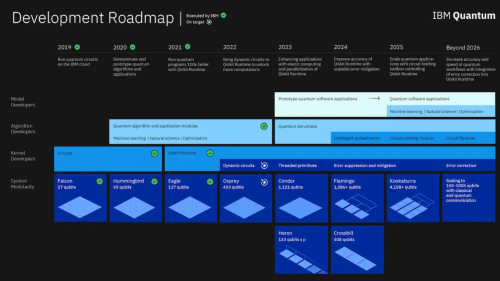IBM has updated its quantum computing roadmap to show how quantum processors, CPUs, and GPUs will be knitted together to create a compute fabric capable of addressing computationally demanding tasks.

“We think we have found what it takes to scale quantum computers into what we’re calling quantum-centric supercomputers,” said Jay Gambetta, IBM fellow and vice-president of quantum computing at IBM. IBM has announced a 133-qubit Heron processor that will be available in 2023, with new gates and tunable couplers to boost speed and reliability.
“We’re also preparing for the ability to control multiple Heron processors with the same control hardware, enabling quantum computing with classical communication between each processor,” said Gambetta. “Heron will allow for classical parallelisation between quantum chips.”
IBM is also working on a chip-to-chip coupler that will allow two-qubit gates to be operated between qubits on different processors. According to Gambetta, IBM plans to release a minimal viable product showing this technology in 2024 – a 408-qubit processor called Crossbill, which is built on the Heron technology and is made up of three chips connected by this modular coupler.
“We will be releasing a demonstration of this architecture by linking together at least three 462-qubit processors, each called Flamingo, into a 1386-qubit system. We expect that this long-range coupler will be slower and lower-fidelity than our on-chip gates, since it involves a physical cable. Our software needs to be aware of this architecture consideration for our users to best take advantage of this system,” said Gambetta.
IBM has also been working on the software side of quantum computing as part of a hybrid approach to give quantum advantage sooner. A issue is effectively decomposed into a sequence of smaller quantum and classical programmes. The data streams are then stitched together into an overall workflow using an orchestration layer. The method is dubbed Quantum Serverless by IBM.
IBM said it was already considering how a future hybrid datacentre for classical and quantum computing might appear, similar to how blade servers revolutionised datacenter design, energy, and cooling requirements.
“Our experience tells us that the requirements of a quantum datacentre are very similar to those of classical datacentres, with addressable solutions to accommodate cryogenic equipment,” said Pizzolato. “Key aspects of datacentre design – such as electrical and cooling water requirements, footprint needs, and the standardisation of infrastructure and system elements – are an integral part of our thought process. We have been able to leverage our deep experience in system and datacentre design to move quickly to design our quantum centres.”





